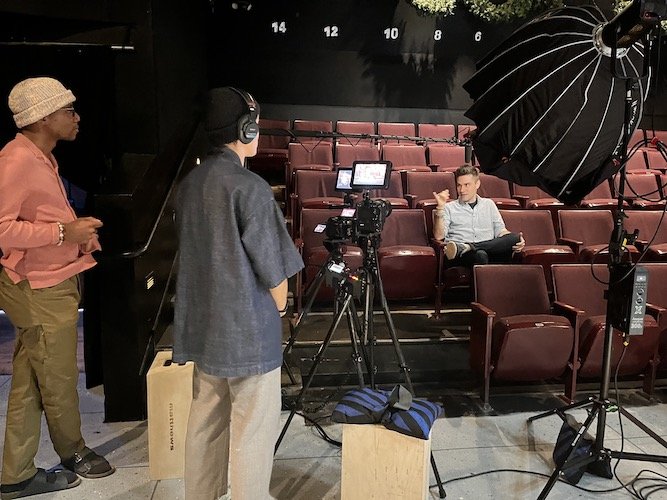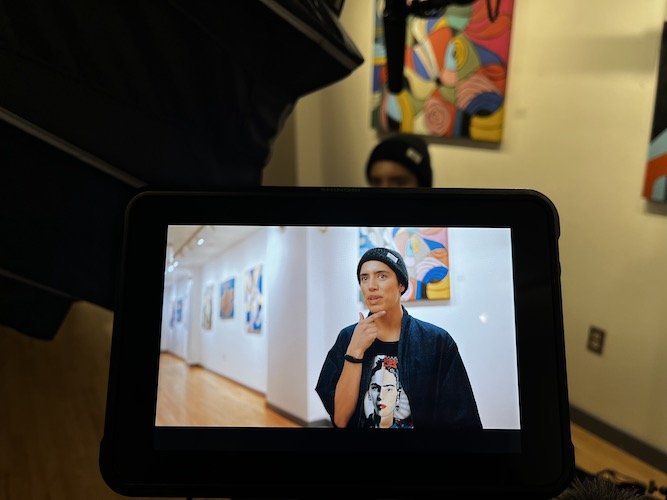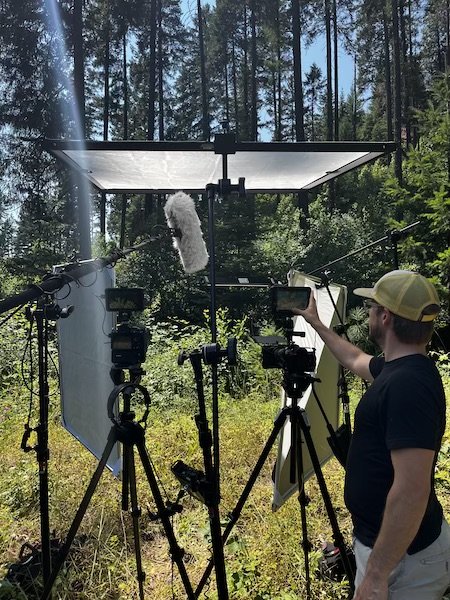Have you ever looked at a photograph and felt as if it was telling you a story? That’s the magic of telling a story with photos, a captivating art form that weaves narratives through visually stunning images.
We'd like to invite you to dive into this fascinating world and discover the secrets to creating compelling photographic stories. From mastering composition and lighting to capturing emotions and experimenting with perspectives, let Tideway Creative light your way!
What You'll Learn
Master the basics of photography to create captivating visual stories.
Use composition and lighting techniques to evoke emotions in your photos.
Experiment with different perspectives and angles for storytelling success!
The Essence of Storytelling Photography
Photographic storytelling is best defined as the art of using images to convey a narrative, evoking emotions and engaging the viewer through characters, emotions, and visual elements.
A photographic story, just like a captivating novel or a compelling film, can transport the audience to different places and times through storytelling pictures, providing a window into the lives of others or even into the realms of imagination. Telling stories through photography is a powerful way to connect with viewers and share experiences, creating impactful visual stories.
Whether it’s a photo essay that follows a chronological narrative structure or a series of abstract images that invite the viewer to create their own stories, the essence of storytelling photography lies in its ability to communicate ideas, emotions, and experiences through stunning pictures. From the iconic works of National Geographic photographers to the personal projects of everyday artists, these images have the power to resonate with audiences and leave a lasting impression.
Keys to Successful Visual Storytelling
Mastering the art of visual storytelling requires a solid foundation in the basics of photography, as well as a keen understanding of how to weave narratives through images. At the core of successful photographic storytelling are three key elements:
Composition
Lighting
Subject matter
These elements work together in harmony to create storytelling pictures that captivate the viewer and convey a powerful message.
We will further examine each of these critical components in the coming sections, offering techniques and tips that can aid in the creation of visually striking images that narrate a story. From the subtle dance of light and shadow to the careful arrangement of elements within the frame, learn how to harness the power of visual storytelling and bring your photographic stories to life.
Composition Techniques
The composition holds significant importance in visual storytelling. It refers to the artistic placement of elements within the frame to guide the viewer’s attention and highlight the narrative’s key points. When crafting a photo story, pay close attention to the balance, symmetry, and structure of your images, as these factors can greatly influence the viewer’s experience and interpretation of the story.
Some well-known composition techniques to consider when creating storytelling images include:
The rule of thirds, which divides the frame into a grid and encourages photographers to place key elements along the lines or at their intersections for a more dynamic and visually appealing result.
Leading lines, which can be utilized to direct the viewer’s attention towards specific subjects or areas of interest.
Framing, which can help to highlight important elements and provide context for the story.
Experimenting with these techniques is not just the practice, but can also enhance your storytelling photography and create a more engaging visual narrative.
Lighting and Mood
In storytelling photography, lighting and mood are instrumental as they set the ambiance, build an atmosphere, and spotlight the narrative’s significant aspects. The interplay of light and shadow can evoke emotions, draw attention to specific elements, and even convey a sense of time and place. By mastering different lighting techniques and understanding how they affect mood, you can create visually appealing images that effectively convey your story.
Some popular storytelling photography tips for lighting include:
Side lighting: This can create dramatic shadows and emphasize texture.
Natural lighting: This can lend a soft, organic feel to your images.
Alternative lighting: Using sources such as candles or lamps can add a unique atmosphere to your storytelling pictures.
Composition and contrast: Playing with composition and contrast can help to balance the overall mood of your visual narrative.
Experiment with these techniques to enhance your storytelling photography and create images that tell a story, captivating your audience.
Choosing the Right Subject Matter
The subject matter forms the core of any photographic narrative, making the selection of an appropriate subject vital for crafting a captivating and engaging storyline. When choosing your subject, consider factors such as its relevance to your intended audience, its ability to evoke emotions, and its potential for visual interest. Engaging subject matter will draw viewers in and allow them to connect with the story on a more personal level.
To ensure your subject matter is engaging, always consider the following:
Look for angles, perspectives, and details that will captivate your audience.
Consider the lighting and mood of the scene.
Employ composition techniques to create a visually appealing image.
Focus on human connections and emotions.
Capture body language, facial expressions, and gestures that convey the story.
By paying attention to these details and creating an emotional connection, you can transform your storytelling photography into a truly immersive experience for your viewers.
Single Image vs. Photo Series
A pivotal decision in storytelling photography is choosing between narrating your story through a single image or a sequence of images. This choice will depend on the complexity of the story you wish to tell and the desired level of viewer interpretation. Both approaches have their merits and challenges, and understanding their strengths and weaknesses can help you make the best choice for your photographic narrative.
A single image has the power to convey a strong message or evoke a specific emotion, but it may not tell the whole story. A photo series, on the other hand, provides the opportunity to present different perspectives and create a more comprehensive narrative. This approach allows for a clear beginning, middle, and end, guiding the viewer through the story in a coherent and engaging manner.
Whether you opt for a single image or a photo series, remember that the key to successful storytelling photography lies in capturing the viewer’s attention and evoking strong emotions through your images.
Capturing Emotions and Human Connections
A striking feature of storytelling photography is its capability to encapsulate emotions and human relationships. By focusing on the relationships between people, their surroundings, and their experiences, you can bring depth and life to your visual narrative. Emotional moments and genuine human interactions can make your storytelling pictures more relatable, engaging, and ultimately, more impactful. With storytelling photographs, you can create a powerful visual story that resonates with your audience.
To capture emotions and human connections in your storytelling photography, follow these tips:
Stay alert and aware of your surroundings.
Trust your instincts and act quickly.
Look for genuine expressions, body language, and gestures that convey emotions and relationships.
Candid shots often have more impact than staged ones, as they capture the raw essence of the moment.
By incorporating these elements into your photographic storytelling, you can create captivating stories that resonate with your audience and leave a lasting impression.
Experimenting with Different Perspectives and Angles
Playing with assorted perspectives and angles can introduce diversity and intrigue into your storytelling photography, stimulating the viewer’s imagination and offering a more rounded narrative. By stepping outside of your comfort zone and trying new approaches, you can discover unique ways to capture your subject and tell your story. This creative exploration can lead to visually appealing images that captivate your audience and make your photographic stories stand out.
Incorporate wide angle shots, close-ups, high-angle views, low-angle perspectives, and other diverse approaches to create a dynamic and engaging visual narrative. By varying your angles and perspectives, you can emphasize different aspects of the story, reveal hidden details, and invite your viewers to explore the scene from multiple viewpoints. This experimentation can enrich your storytelling photography and help you create memorable images that tell a compelling story.
Planning and Preparing for Storytelling Photography
Preparation for storytelling photography entails:
Researching your subject
Scouting potential locations
Devising a shot list
Equipping yourself to adapt to unforeseen circumstances
By taking the time to plan and prepare, you can ensure that your photographic stories are well-crafted, visually appealing, and engaging for your viewers.
Begin by researching your subject and understanding the context of your story. Scout potential locations and consider factors such as lighting, accessibility, and visual interest. Develop a shot list that outlines the key moments, angles, and perspectives you hope to capture.
And remember, even the best-laid plans can change – be prepared to adapt and respond to unexpected situations that may arise during your storytelling photography project. By planning and preparing, you can create images that effectively convey your story and resonate with your audience.
Post-Processing and Editing Techniques
Post-processing and editing methods can augment your storytelling photography by modulating colors, contrast, and other features to underline the narrative and produce visually attractive images. However, it’s important to use these techniques sparingly to maintain the authenticity of your story and avoid creating images that feel overly manipulated or artificial.
Some techniques to consider when editing your storytelling photos include:
Adjusting exposure, contrast, and color balance to improve the overall appearance of your images
Adding vignettes and color grading to create a specific mood and atmosphere
Careful cropping and retouching to enhance the visual impact of your pictures
Remember, the goal of post-processing and editing is to enhance your photographic storytelling, not to create a false or misleading narrative. Use these techniques judiciously to create images that effectively convey your story and captivate your audience.
How Tideway Creative Masters the Art of Storytelling Photography
At Tideway Creative, we've developed a dedication to the art of storytelling in a variety of mediums, to include film as well as photography. Our team deeply demonstrates proficiency in storytelling photography with our distinct approach, meticulous attention to detail, and capability to stir emotions through our images. Nothing excites us more than when we successfully captivate photographic stories that transport viewers to different worlds, inspiring awe and admiration for the power of visual storytelling.
By combining technical expertise with a keen understanding of narrative and emotion, we can successfully create visually appealing images that tell captivating stories. And with careful planning, innovative perspectives, and skillful use of lighting and composition, you too can create images that speak a thousand words!
As we’ve explored in this blog post, the art of storytelling photography lies in the ability to convey stories through stunning pictures that present unique perspectives on interesting subject matter.
Summary
Storytelling photography is a powerful art form that combines technical skills with a deep understanding of narrative and emotion. By mastering composition, lighting, subject matter, and other elements, you can create visually appealing images that captivate your audience and tell compelling stories. Whether you’re experimenting with different perspectives, capturing emotions and human connections, or planning and preparing for your storytelling photography projects, remember that the key to success lies in your ability to convey stories through stunning pictures. So, go out there, explore the world through your lens, and let your images tell the stories that words cannot. And if you'd like some help getting started, feel free to reach out to us here at Tideway Creative to help you tell a story that needs telling!
Frequently Asked Questions
How can I tell a story with just pictures?
To tell a story with pictures, focus on smaller details and capture emotions. Create a shot list to ensure you have all the elements of the story, then experiment with different formats until you get the desired effect. Lastly, choose the best photos that evoke strong emotional feelings and layer them with meaning for maximum impact.
What is a story with pictures called?
A photo story, or photo essay, is a means of visual storytelling that uses images to narrate an event or topic.
Why is it important to tell a story through pictures?
Telling stories through pictures is important because it can make us connect emotionally, evoke atmosphere and emotion, and help the audience relate to what's happening in the story. Photos capture a moment in time that's real and authentic, making them more impactful than ever.
What is the essence of storytelling photography?
Storytelling photography captivates viewers through evocative images that tell a story and elicit emotion.
How can I capture emotions and human connections in my storytelling photography?
Focus on genuine expressions, body language, and gestures to capture emotions and human connections in your storytelling photography. Be alert and aware of the environment to find the perfect moments to capture.









